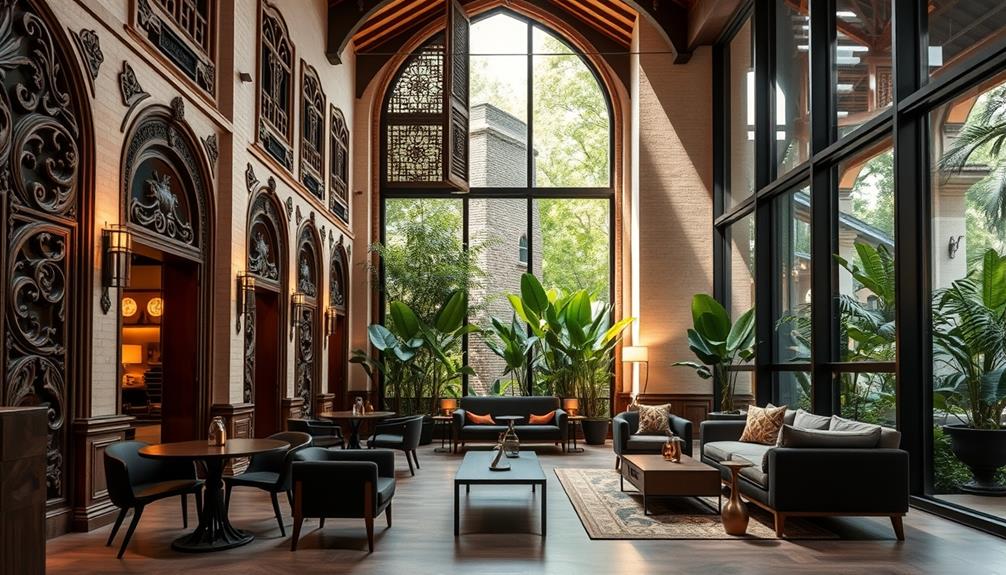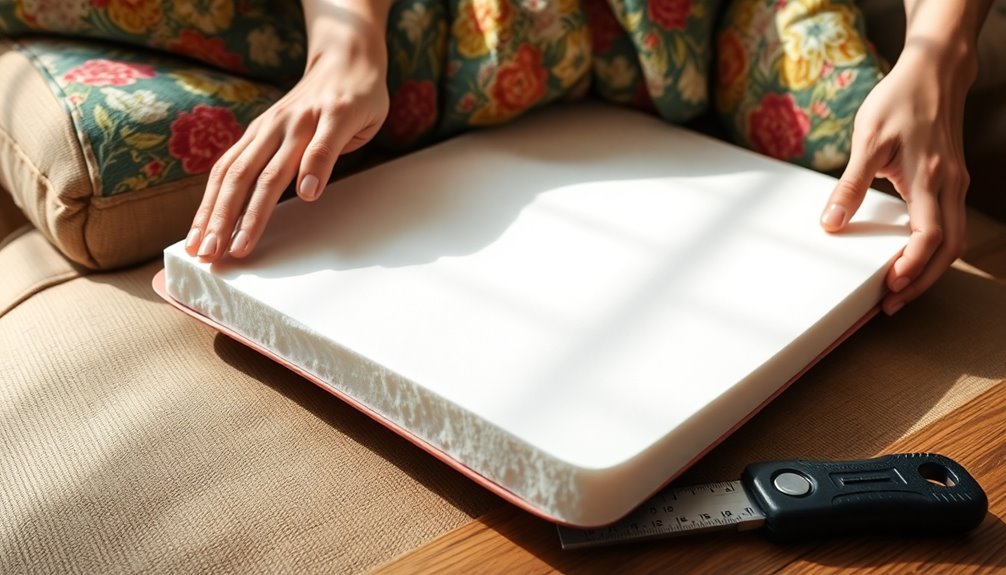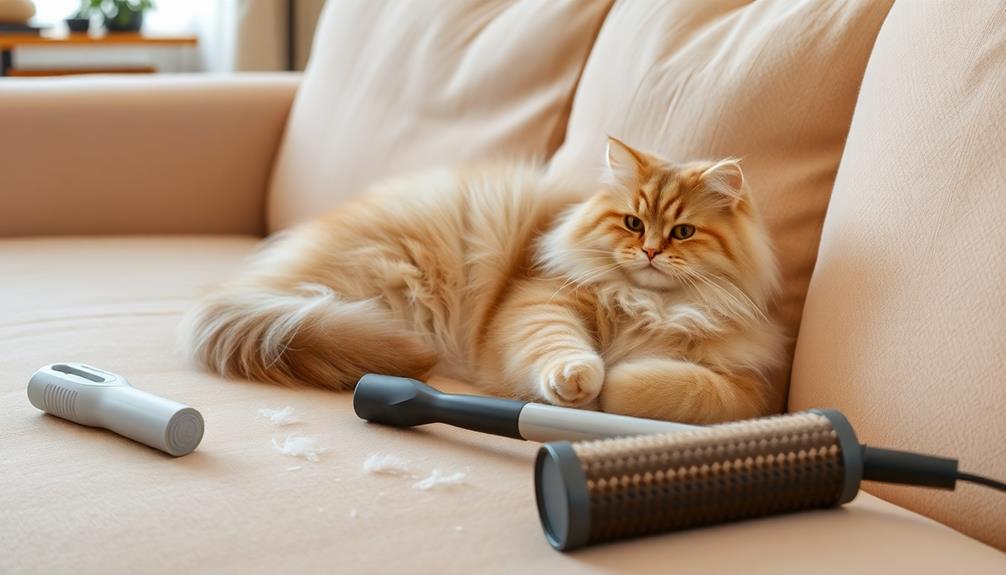To secure furniture to the wall, begin by identifying studs using a stud finder. Attach brackets or straps to these studs for a strong connection, utilizing a cordless drill for installation. Remember to use measuring tape and a pencil to mark the spots before drilling. For extra stability, think about using two straps for tall items. Regularly check the tightness to ensure ongoing safety. If your furniture is very heavy or if you are unsure about the installation, do not hesitate to seek help from a professional. By following these steps, you can establish a safer environment at home – stay tuned for more useful tips! When moving heavy furniture, always use proper lifting techniques to prevent injury. This involves bending at the knees, maintaining a straight back, and using your legs to lift. Consider using furniture sliders to simplify the process and avoid damaging your floors. By taking these precautions, you can guarantee the safety of both yourself and your belongings while reorganizing your space.
Key Takeaways
- Use a stud finder to locate wall studs for secure anchoring, avoiding reliance on drywall anchors.
- Install furniture straps or wall brackets to connect the furniture to the wall for added stability.
- Pre-drill holes slightly smaller than the screws to prevent wall or furniture splitting during installation.
- Regularly check and tighten all straps and screws to ensure ongoing safety and stability of the anchored furniture.
- For heavy or complex items, consider hiring a professional to ensure proper installation and safety.
Importance of Anchoring Furniture
When it comes to creating a safe home environment, anchoring furniture is vital. Each year, around 22,000 injuries related to furniture tip-over incidents occur in the U.S., with nearly 75% of those affected being children. The Consumer Product Safety Commission (CPSC) highlights the tragic reality that a child dies every two weeks from these accidents, often involving heavy items like dressers and TVs.
Understanding financial considerations for elderly care also underscores the significance of a safe living space, particularly for seniors who may be more vulnerable to accidents.
By securing your furniture with furniture anchors, you can markedly reduce these risks and promote Child Safety in your home. The STURDY Act further emphasizes the need for stricter safety standards for dressers, reinforcing the importance of anchoring furniture.
It's essential to be proactive; awareness of the dangers posed by unsecured furniture can help prevent tragic accidents.
Taking the time to properly anchor your furniture is a simple yet effective way to protect your loved ones. Whether you have toddlers climbing or older kids exploring, secure furniture prevents tip-over incidents that could lead to severe injury or worse.
Prioritizing this safety measure not only safeguards your home but also fosters peace of mind for you and your family.
Tools and Materials Needed
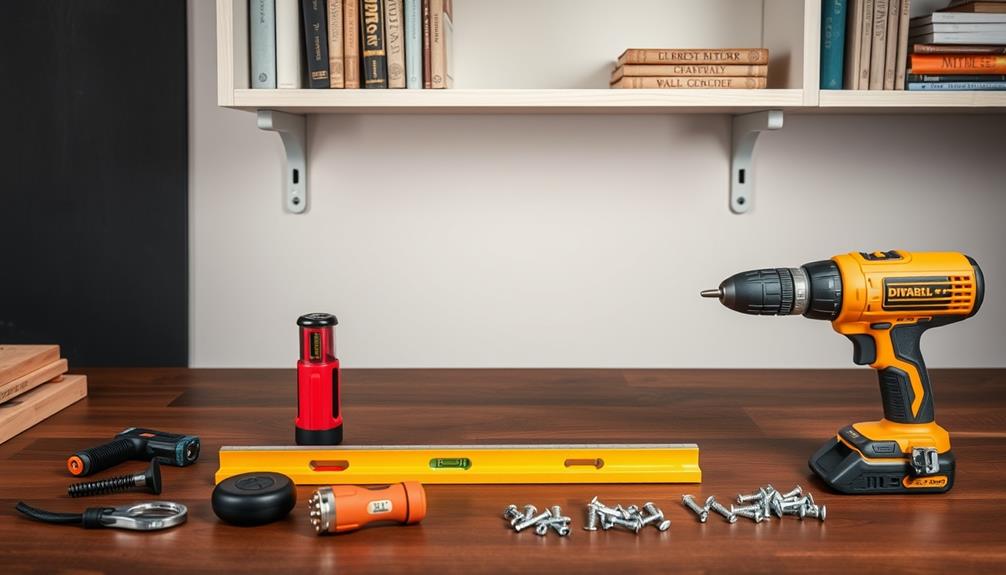
To effectively anchor your furniture and enhance safety, you'll need a few key tools and materials. First and foremost, a stud finder is vital for locating wall studs, which provide the strongest support for anchoring your furniture securely.
It's also beneficial to guarantee good air quality in your space, as air quality considerations can impact your overall environment. Next, a cordless drill or impact driver is recommended for efficiently installing screws and brackets without stripping the wood.
You'll also want to get furniture straps, which usually come in kits that include necessary hardware like brackets and screws. This guarantees you have all components available for proper installation.
To make certain your straps and brackets are placed accurately, a measuring tape is essential. It helps you avoid misalignment during the installation process.
Don't forget to have a pencil handy. It's useful for marking positions on both the wall and the furniture, aiding in precise drilling and bracket placement.
With these tools and materials at your side—stud finder, cordless drill, furniture straps, brackets, measuring tape, and pencil—you'll be well-prepared to anchor your furniture securely and enhance your living space's safety.
Methods to Anchor Furniture

Several effective methods exist for anchoring furniture to walls, ensuring stability and safety in your home. First, you can use wall brackets to securely attach furniture. Connect one bracket to the furniture and the other to a wall stud. This method effectively prevents tip-overs. If you prefer flexibility, employ furniture straps for anchoring. For maximum safety, it's recommended to use two straps per item, allowing movement while ensuring stability. Finally, if you find yourself moving heavy furniture solo, consider investing in furniture anti-tip devices, which can be easily installed with minimal effort. These devices are designed to prevent tipping and provide an extra layer of security for your furniture. Additionally, it’s important to periodically check the stability of your anchored furniture to ensure the safety of your home and family.
| Method | Description | Benefits |
|---|---|---|
| Wall Brackets | Securely attach furniture to wall studs | Prevents tip-overs |
| Furniture Straps | Flexible anchoring option | Allows movement |
| L-Brackets | Added strength for tall/heavy items | Increased stability |
Always remember to anchor furniture to wall studs instead of relying on drywall anchors, which may not withstand lateral forces. For added security, consider using L-brackets, particularly for heavy items. After installation, test the tightness of screws and straps, and periodically check for looseness to maintain safety and stability over time.
When to Seek Professional Help
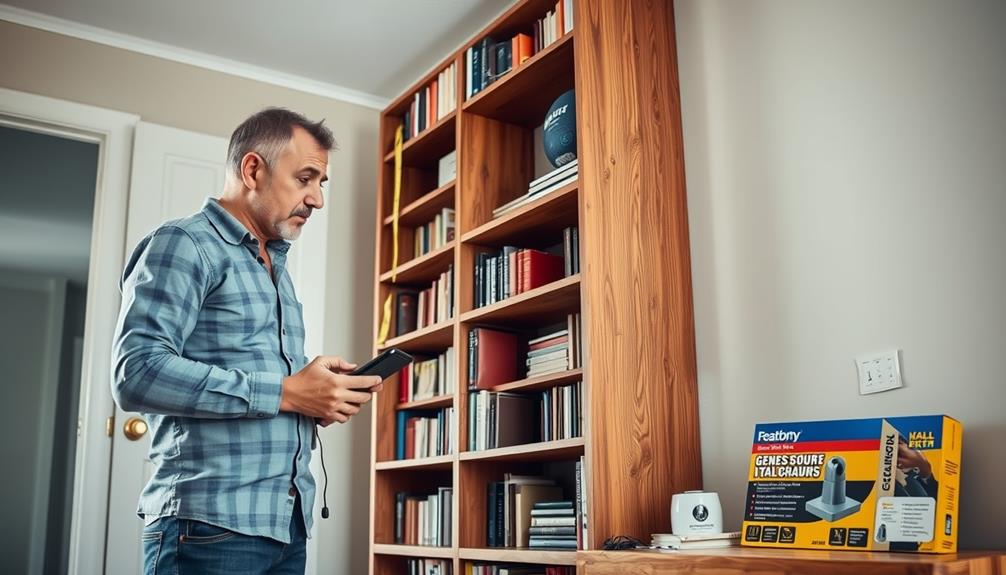
When it comes to anchoring furniture, there are times when you should definitely call in a professional.
If you're dealing with heavy pieces, complex layouts, or tricky wall types like brick or concrete, getting expert help can save you from potential headaches and guarantee safety.
Additionally, if you have young children or pets at home, confirming that furniture is securely anchored can prevent accidents and injuries, making it essential to evaluate cold medications overview when prioritizing safety.
Don't hesitate to seek assistance if you're unsure about your skills or the right tools for the job.
Complex Installation Scenarios
Complex installation scenarios often arise when you're anchoring furniture to challenging surfaces or dealing with heavy items.
If you're facing brick or concrete walls, it's wise to seek professional help, as these require specialized tools like hammer drills and masonry bits. Trying to secure the bracket without the right equipment can lead to improper installation and potential hazards.
If your furniture is unusually heavy or unstable, a professional assessment guarantees that safety measures are followed.
For complex installations involving multiple pieces or intricate layouts, hiring an expert can provide peace of mind and confirm that your anchors are correctly placed.
It's also essential to take into account your DIY skills. If you lack the necessary tools or experience, consulting a professional can prevent issues down the line.
Large entertainment centers or tall bookshelves, for instance, often benefit from expert installation to maintain maximum safety and stability.
Remember, when in doubt, it's better to invest in professional assistance than risk the safety of your home and loved ones.
Taking these steps will help guarantee your furniture is securely anchored and your space remains safe.
Heavy Furniture Considerations
Heavy furniture, like large dressers or entertainment centers, can create serious tipping hazards if not anchored properly. If you're dealing with heavy furniture that seems unstable or tricky to secure, it's wise to seek professional help.
These experts know the best anchoring techniques to minimize tipping risks, ensuring your furniture stays upright.
When considering whether to anchor your furniture yourself, think about the complexity of the installation. For instance, if you're anchoring multiple pieces or dealing with intricate wall structures, professional installation may be necessary.
They've specialized tools, like hammer drills and masonry bits, which are essential for anchoring to brick or concrete walls.
Additionally, if you have active children, ensuring that heavy furniture is safely secured can provide you with peace of mind. A professional can help you secure the bracket correctly and verify that everything is stable.
Wall Type Challenges
If you encounter walls made of brick, concrete, or particularly dense materials like plaster, anchoring furniture can become a challenging task. You might need specialized tools, such as a hammer drill and masonry screws, to get the job done right.
If the wall material is dense, locating wall studs might require a magnetic stud finder, complicating your DIY efforts.
Consider these factors when deciding whether to tackle the project yourself or seek professional help:
- Furniture weight: If your furniture is excessively heavy, it's essential to guarantee it's anchored securely to prevent furniture tip-over.
- Complex installations: Multiple pieces of furniture or unique configurations can exceed basic DIY skills, making hiring a professional a smart choice.
- Safety concerns: In homes with children, safety is paramount. Hiring a professional guarantees that brackets and drywall anchors are installed correctly.
Ultimately, if you feel uncertain about your ability to anchor your furniture safely, don't hesitate to seek professional help. It's better to invest in expertise than risk accidents caused by improperly secured furniture.
Understanding Furniture Tip-Over Risks

When you think about furniture tip-over risks, it's essential to recognize the serious injuries they can cause, especially to children.
Statistics reveal that a child dies every two weeks from these accidents, making it clear that unsecured furniture poses a significant danger.
Understanding these risks can help you take proactive steps to keep your home safe.
Common Injuries Overview
Furniture tip-over incidents can lead to serious injuries, especially in homes with children. Each year, over 22,000 injuries related to furniture tip-overs are reported in the U.S., with children accounting for nearly half of these.
Unfortunately, the risks are significant, as unsecured furniture can result in injuries and even deaths.
To maximize safety, consider these key factors:
- Anchor furniture: Secure bookshelves, dressers, and heavy items to the wall to prevent tipping.
- Baby proofing: Implement strategies to minimize risks, such as keeping heavy items off high shelves.
- Awareness: Stay informed about the dangers of furniture tip-overs and how to prevent them.
With 11 children dying each year from these accidents, it's essential to take action.
Heavy items placed on high shelves can increase the risk of furniture tipping over, particularly for curious kids who might climb or pull on furniture.
Statistics on Fatalities
Understanding the statistics surrounding furniture tip-over fatalities reveals the urgent need for safety measures in homes, especially those with young children. Each year, over 22,000 injuries related to furniture tip-overs are reported in the U.S., a stark reminder of the risks associated with unsecured furniture.
Between 2018 and 2020, there were 581 fatalities linked to these incidents, with children under five accounting for 81% of the deaths. That's a child dying every two weeks due to preventable accidents.
To enhance Wall Safety, it's critical to secure furniture to the wall, particularly in rooms where your first child plays. Using anchoring kits can effectively minimize the risk of furniture tip-overs. When you anchor furniture, you're not just protecting your child; you're also providing peace of mind.
Mark the wall where you intend to install these safety measures, ensuring everything is properly secured. The efforts of safety campaigns have already shown a 55% decrease in emergency medical attention for tip-over incidents, proving that proactive steps can save lives.
Don't wait for a tragedy; take action now to safeguard your home.
Consumer Awareness and Safety Education

Safety awareness is essential in preventing tragic accidents related to furniture tip-overs, especially in homes with children. Every year, about 22,000 injuries are reported in the U.S., with children being the most affected demographic.
To combat this serious issue, you need to prioritize consumer awareness and safety education within your home.
Here are some effective safety measures you can implement:
- Educate family members: Teach everyone about the risks associated with unsecured furniture. Understanding these dangers can encourage responsible behavior.
- Choose compliant furniture: Look for dressers and other furniture that adhere to the STURDY Act's safety standards to guarantee better stability.
- Properly anchor furniture: Use a drill to secure your furniture to the wall with appropriate anchors and studs to prevent tip-overs.
DIY Projects for Enhanced Safety

Anchoring furniture securely can be a rewarding DIY project that enhances your home's safety while giving you a chance to personalize your space. By taking the time to secure heavy items, you're not only making your home safer but also customizing your environment.
Start by gathering essential tools like a stud finder, cordless drill, and screwdrivers.
Next, mark the locations where you'll attach furniture brackets to the wall. This step is essential for ensuring that your furniture stays in place. After marking, drill pilot holes for easy installation.
Using metal brackets or nylon straps, connect your furniture to the wall, providing a robust anchor that reduces the risk of tip-overs.
This DIY project typically takes 30 minutes to an hour, making it a quick yet impactful solution to a significant safety concern.
Remember to conduct regular maintenance checks on your anchored furniture, testing the tightness of straps and fasteners.
Tips for Effective Installation

When you're ready to install your furniture anchors, start by locating the wall studs with a stud finder—this step is vital for securing a strong connection. Anchoring into the studs behind your drywall will provide the most stability for your furniture.
Next, pre-drill holes slightly smaller than the screws you'll use. This guarantees a snug fit and prevents the wood from splitting during installation.
After that, attach the bracket on the wall while using a level to guarantee everything's aligned straight. Proper alignment is essential for maintaining stability in your anchored furniture.
Here are a few tips to keep in mind:
- Always follow the manufacturer's instructions for the specific anchoring kit you're using; different kits may have unique installation requirements.
- Regularly check and tighten the straps or screws after installation to guarantee ongoing safety.
- If you're securing large or heavy furniture, consider using multiple anchors for extra support.
Frequently Asked Questions
What Is the Best Way to Secure Furniture to the Wall?
To secure furniture effectively, you should use anchors or straps that attach to wall studs. This method enhances stability, prevents tip-overs, and guarantees safety, especially in homes with children. Regularly check the tightness for ongoing security.
How to Anchor Furniture to a Wall Without a Stud?
When you need to anchor furniture without a stud, use heavy-duty wall anchors like toggle bolts. Pre-drill holes, check alignment with a level, and regularly inspect the anchors for safety and stability.
How Do You Anchor Freestanding Furniture?
To anchor freestanding furniture, use a stud finder to locate studs, then drill pilot holes for screws. Attach brackets securely, align the furniture, and utilize safety straps for added stability and safety against tip-overs.
How to Attach a Dresser to the Wall?
You need security for that dresser, right? Start by finding the studs in your wall. Mark, pre-drill, and attach brackets to both the dresser and wall. Don't forget those safety straps for extra peace of mind!
Conclusion
By anchoring your furniture, you're not just protecting your space; you're safeguarding your loved ones. Imagine the peace of mind that comes with knowing your home is a secure haven. With the right tools and methods, you can easily prevent tragic accidents and create a safer environment. So, take a moment to anchor those pieces today—because in a world full of uncertainty, your home should be a refuge, not a risk.

